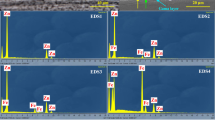Abstract
The lightfastness declarations of several different commercial acrylic paints and different quality series were tested by artificial UV ageing. To evaluate their lightfastness declarations, three acrylic colours (cadmium red, ultramarine blue and chromium oxide green) from six companies (Lascaux, Liquitex, Lukas, Rembrandt, Schmincke, and Winsor & Newton) were analysed before and after UV exposure. Characterisation and identification of these materials were carried out with Py–GC/MS, FTIR–ATR analyses, and colour measurements. Particular attention was focused on the Py–GC/MS measurements and on comparison of the single-shot method for pyrolysis of polymers and the double-shot mode which enables a unique combination of pyrolysis methods for analysis of polymers and thermal desorption for documentation of the volatile compounds. Depending on the particular company and the specific value of the lightfastness declaration, different binding media (i.e. poly(EA/MMA), poly(nBA/MMA), and poly(2-EHA/MMA)), and fillers (i.e. kaolinite, calcium carbonate, barite, and talc) were characterised and identified by Py–GC/MS and FTIR–ATR analyses. After UV exposure, several alteration processes with consequent formation of volatile compounds or new products were observed by both techniques, especially for the blue paints. In particular, the double-shot mode of Py–GC/MS enabled the detection of oxidation products, which could not be detected with the single-shot mode. Comparison of the lightfastness declarations for each of the blue, green, and red paints and the noted alterations broadly agreed for most of the paints.










Similar content being viewed by others
References
Learner T (2004) Analysis of modern paints. The Getty Conservation Institute, Los Angeles
Scalarone D, Chiantore O (2004) J Sep Sci 27:263–274
Pintus V, Schreiner M (2011) Anal Bioanal Chem 399:2961–2976
Sonoda N, Rioux JP (1990) Studies Conserv 35:189–204
Sonoda N, Rioux JP, Duval AR (1993) Studies Conserv 38:99–127
Chiantore O, Scalarone D, Learner T (2003) Int J Polym Anal Ch 8:67–82
Jones FN, Mao W, Ziemer PD, Xiao F, Hayes J, Golden M (2004) Prog Org Coat 52:9–20
Learner T (2000) The Conservator 24:96–103
Boon JJ, Learner T (2002) J Anal Appl Pyrol 64:327–344
Stringari C, Pratt E (1991) The identification and characterization of acrylic emulsion paint media. In Saving the Twentieth Century, Ottawa, Canada, pp 411–440
Learner T (1995) ‘The analysis of synthetic resins found in twentieth-century paint media’ in Pre-prints, Resins: Ancient and Modern. Scottish Society for Conservation and Restoration, Edinburgh, pp 76–84
Learner T (2007) In: Learner T, Smithen P, Krueger JW, Schilling MR (eds) Modern paints uncovered. The Getty Conservation Institute, Los Angeles
Ormsby B, Kampasakali E, Miliani C, Learner T (2009) e-PS 6:186–195
Ormsby B, Learner T, Foster G, Druzik J, Schilling M (2007) In: Learner T, Smithen P, Krueger JW, Schilling MR (eds) Modern paints uncovered. The Getty Conservation Institute, Los Angeles
Hoogland FG, Boon JJ (2009) Int J Mass Spectrom 284:66–71
Hoogland FG, Boon JJ (2009) Int J Mass Spectrom 284:72–80
Dickson T (1988) In: Lewis PA (ed) Pigment handbook, vol 1, 2nd edn. New York, Wiley
Liquitex Artist Materials (2011). http://www.liquitex.com/AboutUs/. Accessed 10 May 2011
Schmincke Acrylfarben (2011). http://www.schmincke.de/. Accessed 10 May 2011
Lascaux Colours & Restauro (2011). http://lascaux.ch/de/index.php. Accessed 10 May 2011
Lukas Künstlerfarben – seit 1862 (2011). http://www.lukas.eu. Accessed 10 May 2011
Winsor & Newton – The World’s Finest Artists’ Materials (2011) http://www.winsornewton.com/ Accessed 10 May 2011
Learner T, Chiantore O, Scalarone D (2002) “Ageing studies on acrylic emulsion paints”, Preprints ICOM Committee for Conservation 13th Triennial Meeting. James & James (Science Publishers), Rio de Janeiro, pp 911–919
Whitmore PM, Colaluca VG (1995) Studies Conserv 40:51–64
Melo MJ, Bracci S, Camaiti M, Chiantore O, Piacenti F (1999) Polym Degrad Stabil 66:23–30
Scalarone D, Chiantore O, Learner T (2005) “Ageing studies of acrylic emulsion paints. Part II. Comparing formulations with poly(EA-co-MMA) and poly(nBA-co-MMA) binders ”Preprints ICOM Committee for Conservation 14th Triennial Meeting. James & James/Earthscan, The Hague, pp 350–358
Chiantore O, Lazzari M (2001) Polymer 42:17–27
Chiantore O, Trossarelli L, Lazzari M (2000) Polymer 41:1657–1668
Doménech-Carbó MT, Silva MF, Aura-Castro E, Fuster-López L, Kröner S, Martínez-Bazán ML, Más-Barberá X, Mecklenburg MF, Osete-Cortina L, Doménech A, Gimeno-Adelantado JV, Yusá-Marco DJ (2011) Anal Bioanal Chem 399:3155–3304
ASTM International (2011) D5383 – 02 (Reapproved 2010)
ASTM International (2011) D5398 – 97 (Reapproved 2010)
Hellgren AC, Weissenborn P, Holmberg K (1999) Prog Org Coat 35:79–87
Vahur S, Teearu A, Leito I (2010) Spectrochim Acta A 75:1061–1072
Feller-Johnston R (2001) Color science in the examination of museum objects nondestructive procedures. The Getty Conservation Institute, Los Angeles
Allen NS, Parker MJ, Regan CJ, McIntyre RB, Dunk WAE (1995) Polym Degrad Stab 47:117–127
Nellamy LJ (1975) The infrared spectra of complex molecules. Chapman and Hall, London
Acknowledgements
This work was funded by Regione Sardegna (Italy), “Programma Master and Back anno 2009” Alta Formazione and the Austrian Science Fund, project no. L699-N17. We thank Oscar Chiantore (Department of I.P.M. Chemistry and Nanostructured Interfaces and Surfaces-Centre of Excellence, University of Torino, Italy) for fruitful discussion and valuable cooperation on ageing studies of acrylic materials. We also thank Rebecca Ploeger (National Gallery of Art, Washington, DC, USA) for openly sharing her knowledge and for helping with the English corrections. Moreover, we are grateful to Antonia Cecini (Faculty of Chemistry, University of Pavia, Italy) for carrying out the FTIR–ATR and colour-measurement analyses.
Author information
Authors and Affiliations
Corresponding author
Additional information
Published in the special issue Analytical Techniques in Art, Archaeology and Conservation Science with guest editor Oliver Hahn.
Rights and permissions
About this article
Cite this article
Pintus, V., Wei, S. & Schreiner, M. UV ageing studies: evaluation of lightfastness declarations of commercial acrylic paints. Anal Bioanal Chem 402, 1567–1584 (2012). https://doi.org/10.1007/s00216-011-5369-5
Received:
Revised:
Accepted:
Published:
Issue Date:
DOI: https://doi.org/10.1007/s00216-011-5369-5




